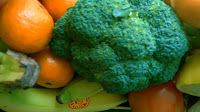We’ve all heard that
organic is better for our health, better for our food systems, and better for the
environment. Many of us have even heard
about the so-called “dirty dozen” of foods that are most harmed by pesticide
and other chemical interactions, but there are also a “clean 15.” These are produce items that we can
save a little money on and not always go organic, and are still ok for our
health.
What does organic really mean?
According to the USDA National Organic Program (NOP) defines
organic as follows:
“Organic food is produced by farmers who emphasize the use of renewable resources and the conservation of soil and water to enhance environmental quality for future generations. Organic meat, poultry, eggs, and dairy products come from animals that are given no antibiotics or growth hormones. Organic food is produced without using most conventional pesticides; fertilizers made with synthetic ingredients or sewage sludge; bioengineering; or ionizing radiation. Before a product can be labeled "organic," a Government-approved certifier inspects the farm where the food is grown to make sure the farmer is following all the rules necessary to meet USDA organic standards. Companies that handle or process organic food before it gets to your local supermarket or restaurant must be certified, too.”
“Organic food is produced by farmers who emphasize the use of renewable resources and the conservation of soil and water to enhance environmental quality for future generations. Organic meat, poultry, eggs, and dairy products come from animals that are given no antibiotics or growth hormones. Organic food is produced without using most conventional pesticides; fertilizers made with synthetic ingredients or sewage sludge; bioengineering; or ionizing radiation. Before a product can be labeled "organic," a Government-approved certifier inspects the farm where the food is grown to make sure the farmer is following all the rules necessary to meet USDA organic standards. Companies that handle or process organic food before it gets to your local supermarket or restaurant must be certified, too.”
But where can we save money and which foods are best to buy organic?
I just moved back to Sacramento, CA from Honolulu, HI, and the food
freshness, availability, and cost is dramatically different in California. I’m
starting a healthier, safer path for my diet and product use since I’ve moved
back. Now that I can afford to buy
some fresh, organic produce, I’ll share with you which fruits and veggies are
better organic.
Buy organic (when available):
- · Apples
- · Blueberries (Domestic)
- · Celery
- · Sweet Bell Peppers
- · Cherries
- · Cranberries
- · Cucumbers
- · Grapes
- · Green beans
- · Kale/Greens
- · Lettuce
- · Nectarines (imported)
- · Peaches
- · Peas
- · Potatoes
- · Spinach
- · Strawberries
- · Tomatoes
The reason for this is
both the kinds of pesticides and harmful residues that are left on these
produce, and the vulnerability of the skin to absorb harmful chemicals.
Save your money: (the clean ones)
Foods with thicker
skins, like bananas, need not be bought organic if you’re trying to save a few
bucks. Here are the “clean 15”
based on Environmental Working Group’s study published in 2012:
- · Asparagus
- · Avocado
- · Cabbage
- · Cantaloupe (Domestic)
- · Eggplant
- · Grapefruit
- · Kiwi
- · Mango
- · Mushrooms
- · Onions
- · Pineapple
- · Sweet Corn (but may contain GMO’s)
- · Sweet Peas
- · Sweet Potatoes
- · Watermelon
There’s an app for that!
Check out
Environmental Working Group’s website to download a free app for Android, iPhone,or a Windows phone to help you shop for the clean 15 and dirty dozen!
More resources:
USDA Website: http://www.ams.usda.gov/AMSv1.0/nop
That’s it for this
week! Thanks for reading and feel free to post comments or questions.
Stay tuned next week
as we give a little glimpse into a new restaurant called ‘The Green Boheme’ in Sacramento and
Dr. Priscilla Monroe. RN, ND’s tasty meal there!
Have a healthy week! Send us any questions to drmomnaturopath(at)gmail.com!
Briana


No comments:
Post a Comment